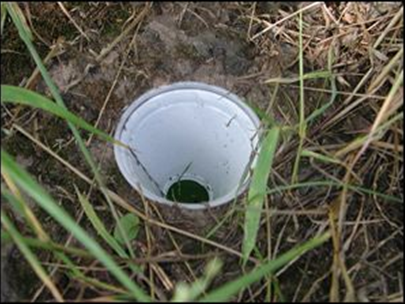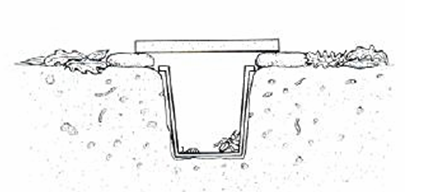3. Collecting of Ground-Dwelling Insects Using Pitfall Traps
30.11.2014
In the next few displays we will cover other ways of collecting insects. We will leave plant vegetation and focus on the insect which lives on the surface of the ground or in its upper layer. At the end of this article you will find out something about data you must write down during each collection.
 |
| Pitfall traps |
Pitfall traps
Insects living on the surface of the ground, primarily specimens with an inconspicuous way of life, can be collected by pitfall traps. This kind of insect is hard to spot during the day, they are usually hidden in their hiding places, and such specimens are active primarily at night. In comparison to the previous methods, a pitfall trap is a very effective way of collecting with minimum effort. This method is convenient for research of the whole epigone (of ground-dwelling insects).
A pitfall trap is a simple instrument for insect trapping. There are a lot of types of pitfall traps available but they are always a container filled with preservative fluid or different bait embedded into the ground. You simply dig out a hole with the size of the container, which you then place inside, and then compact the surroundings of the hole.
The neck of the container should be at the ground level. Any possible gap between the ground and the trap needs to be stopped up. For example, you can use glass, plastic cups, or cans as a pitfall container: the best way is to use a pair of plastic cups inserted into each other.
In that case, the collecting of traps is effortless. The outer plastic cup remains embedded in the soil and you only pull out the inner cup with the catch. Glass or metal can traps must be dismantled after any collecting.
The construction of a pitfall trap also consists of a roof. It prevents rain drops, falling leaves, and other unwanted material from getting into the trap. The roof can be constructed of natural material (such as a piece of bark, the cutting of a wood, or flat stone), or of artificial material (metal, plastic, or another type of small desk). Gaps between the neck of the container and the roof can be achieved by supports (stones, poles, etc.).
Preventing vertebrates (mice, reptiles) from getting into the trap can be pre-empted by placing netting with a different diameter of meshes on the neck of the container. This way you can also select the size of the collected insect. The construction of the pitfall trap can be improved by placing a funnel (the same as amphibian trappings on roads)
 |
| A pitfall trap |
Pitfall traps with bait
Pitfall traps with bait is a separate chapter of insect selection. Different bait can attract different species of insects. The selection of the proper bait is often by way of experiment.
Pitfall traps frequently catch Carabidae. For bait is mainly used a piece of meat, cheese, or a beer. Alternatively, yeast, vinegar with salt, or dung works very well. Other than Carabidae are often trapped Staphylinidae, Silphidae, Araneae, and larval stages of other groups of invertebrates.
Pitfall traps can be filled with:
- only bait
- bait with preservative fluid
- only preservative fluid
The container should be filled to 1/3 of its height. The fluids that can be used in these traps include formaldehyde (4%), ethylene glycol (5%), propylene glycol, sodium chloride solution, or ethylene glycol and water solution, etc.
The frequency of sampling is then influenced by the type of preservative used, as well as the physical characteristics of the environment, the weather, and the experiences of the collector. Between the most common frequencies of sampling, once a day, every other day, and once a week top the list. The trapped individuals should then be shifted to the collecting bottle, and the pitfall trap installed back in its place. It is also important to write down data about the collecting.
Collecting data
Ideally, every collection should have its original number, or a sign. It is suitable to use biographic classification of a terrain when the collecting is extensive.
Every killing bottle or bag with collection should be immediately marked in terrain to avoid mixing up the collected material. Besides the number of locality it is convenient to write down:
- GPS locality
- height above sea level
- exposition, state of biotope (flowery meadow, mixed forest)
- temperature
- type of weather
The date is a matter of course, and it is also convenient to write down the time of day. Some of this data will be mentioned and applied in articles about preparation of insects in the future.
Author: David Mazáč
Categories
- Novelties
-
Preparation
- Black insect pins
- Stainless steel pins
- Minuten pins
- Plastic headed pins
- Label pins white
- Setting boards for Lepidoptera - LIMEWOOD
- Setting boards of BALSA
- Plastazote setting boards
- Portable suitcase for balsa spreaders
- Pergamine setting strip
- Foam bases
- Pinning block
- Mounting boards
- Sexual boards
- Mounting glues
- For microscopy
- Setting needle
-
Storing equipment
- Portable boxes
- Portable bilateral small suitcases
- Boxes with full lid
- Display boxes
- Entomological wooden display boxes
- Boxes without foam on the bottom for CARTON UNIT SYSTEM
- Carton UNIT trays for CARTON UNIT SYSTEM
- Boxes without foam on the bottom for PLASTIC UNIT SYSTEM
- Plastic UNIT trays for PLASTIC UNIT SYSTEM
- Entomolgical cabinets
- Entomological wooden drawers
- Entomological wooden drawers for CARTON UNIT SYSTEM
- Preservation
-
Field equipment
- Eclectors
- Exhaustor
- Killing fluids
- Syringes
- Butterfly nets and other equipment
- Stopper for killing bottles
- Fillings for killing bottles
- Malayse traps
- Polyethylene killing bottles
- Night field equipment
- Litter reducers
- Butterfly bags
- Aquatic nets
- Tree bark net
- Clap net (Japanese umbrella)
- Sweeping nets and other equipment
- Tree traps
- A Simple Raid Trap
- Other equipment
- Literature
